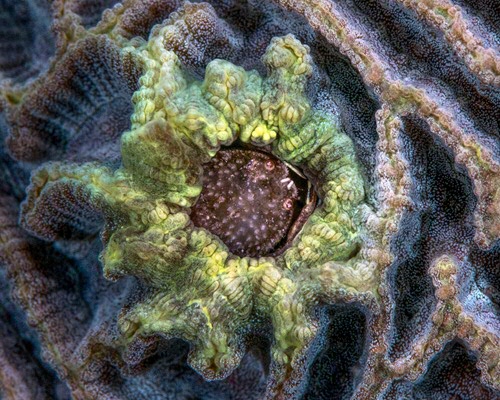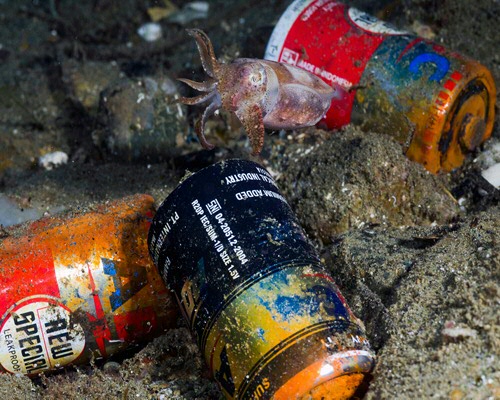Diving into the rainbow
Sancia van der Meij grew up surrounded by the heaths and forests of Drenthe, but when she as an 18-year-old learnt to dive on coral reefs, she was committed. She would become a marine biologist. By studying tiny gall crabs, she is now exploring how invertebrates live together on species-rich coral reefs. She recently co-produced as scientific advisor on a book with photographer Alan Powderham on underwater life in the Coral Triangle in South-East Asia: At the Heart of the Coral Triangle – Celebrating Biodiversity, a ‘scientific coffee table book’.
You are a scientist with a love for coral, which is not doing well at the moment. Is this a book with a message?
Using over 300 carefully selected and themed photos, this book vividly displays the beauty of underwater life in the Coral Triangle. These coral reefs harbour the world’s highest diversity of marine species. I am studying biodiversity through tiny, coral-inhabiting gall crabs – but of course, everything is connected. The strong synergy and collaboration with the leading author, Alan Powderham, is based on our shared fascination and passion for the enormous diversity of species found on coral reefs. Our book provides a window into the wonderful world of the organisms that thrive on these reefs: from crabs that elaborately decorate themselves and little snails that take on the form and colour of their host coral to fish in all colours of the rainbow. Every species is uniquely adapted to its environment and many species have yet to be scientifically studied. We hope to spread the message of how importantly these coral reefs deserve our attention and protection.
Where does your interest in gall crabs stem from?
I have always found invertebrates fascinating because of the enormous variety in form and lifestyles. The sea has been a strong attraction ever since I was young, even though I grew up among the heaths and forests of Drenthe. When I was 18 I learnt to dive on a coral reef while travelling through Central America. From that moment on, I knew that I wanted to become a marine biologist. I very much enjoy combining my fondness for both invertebrates and the sea, and by close observation of ‘my’ gall crabs, I am able to gain an understanding of how species live together and adjust to their specific habits – and how new species may arise from this.

Considering the worsening situation of coral, is there still actually enough to dive into?
There are – fortunately – still many fantastic spots where you can dive and enjoy rich coral reefs. But even at these beautiful and often remote places, we observe coral bleaching as a result of climate change, as well as the effects of pollution from plastic and other rubbish. The absence of large fish, such as sharks, is also a disturbing sign. It is concerning that the influence of humans is always evident, wherever you are.
We don’t always see what is happening underwater. Is that a disadvantage in terms of the interest for coral and for your research?
Yes, definitely, I would agree with that. A lot less is known about the processes and diversity in our oceans compared to land. Of course, marine research is more difficult to carry out: time periods to conduct research are limited if you need to snorkel or dive and access to boats and equipment is often expensive and limited , too. It is precisely because it is harder to see what is happening underwater that fewer people get to know about the beauty of marine flora and fauna. Hopefully, our book can help to change this!
You must come across extraordinary things in your research. Can you give us an example?
Fieldwork often consists of long days of diving, after which samples need to be processed in a primitive field lab deep into the night. But I will never forget the time that we dove, almost every day, in areas inhabited by salt-water crocodiles – especially because the local population had seen them just recently present!

In addition to your position at the UG, you also work at the Naturalis Biodiversity Center in Leiden. Do these two jobs complement one another?
The UG is my primary employer, and I am a honorary research associate at Naturalis. I obtained my PhD in Leiden and my scientific samples are mainly stored in Naturalis’ scientific collections. As a guest researcher I can easily remain in contact and collaborate with colleagues at Naturalis, hence I have the best of both worlds.
Is it still possible to go abroad for research, or are you staying in Groningen and Leiden for now?
For the most part, I am staying in Groningen at the moment, also because my second baby was born earlier this year. But I fortunately still have data that I need to process and online teaching is very time consuming. It is however it creates serious challenges for my PhD students. They can’t go into the field to collect data and are experiencing significant delays in their research. I am trying to collect samples and data with the help from international colleagues so that they can still, at least partly, continue their research. I hope that 2021 will be a better year in many ways!
More information
More news
-
15 September 2025
Successful visit to the UG by Rector of Institut Teknologi Bandung
